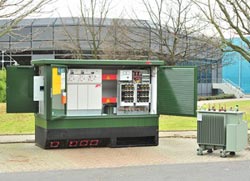Smart Grid Test as Part of the Energy Transition

<br>
The two companies want to test the smart grid's behavior and technology in practice. Due to its large share of renewable sources of energy, Wachtendonk serves as a sort of role model for Germany's energy transition.
The town's 8,000 inhabitants get about 80 percent of their electricity from photovoltaic systems or other sources of renewable energy.
As a result of the energy transition, Germany's power grid is being transformed from a demand-controlled “one-way street” into a bidirectional-flow network. Energy can be fed into and out of the system at a variety of locations. However, the amounts of wind and solar power supplied vary. The result is voltage fluctuations in the grid and an increased risk of a power outage in parts of the grid under high load. The power grid of the future will have to offset such fluctuations better by actively monitoring voltages and automatically regulating them.
As part of its grid modernization program, SWK installed empty data transmission line pipes in the Wachtendonk grid in 2010 and ensured that 52 of the 105 local electrical substations were capable of receiving smart grid components. The company is now installing smart meters from Siemens in numerous distribution boxes and at 100 of the town's households.
The smart meters have a power snapshot function, which enables them to take “snapshots” of the current grid condition in addition to supplying data on electricity consumption. The meters also transmit the measurement values to local smart substations, which consist of compact medium-voltage switchgear and adjustable local grid transformers, as well as of remote control systems, grid protection technology, and transmission systems.
State-of-the-art sensor and communications technology makes the substations “smart.” The integrated adjustable local grid transformers from Siemens stabilize the grid at the interface between low-voltage and medium-voltage networks. On a cloudless day, for example, the data from the smart meters might show that voltage is increasing while electricity consumption is low.
This would mean that photovoltaic systems are feeding large amounts of power into the grid and the transformer would consequently adjust the voltage. Smart, automated grids are part of Siemens' environmental portfolio, with which the company generated approximately €33 billion in sales in business year 2012.
Media Contact
More Information:
http://www.siemens.com/innovationnewsAll latest news from the category: Power and Electrical Engineering
This topic covers issues related to energy generation, conversion, transportation and consumption and how the industry is addressing the challenge of energy efficiency in general.
innovations-report provides in-depth and informative reports and articles on subjects ranging from wind energy, fuel cell technology, solar energy, geothermal energy, petroleum, gas, nuclear engineering, alternative energy and energy efficiency to fusion, hydrogen and superconductor technologies.
Newest articles

Superradiant atoms could push the boundaries of how precisely time can be measured
Superradiant atoms can help us measure time more precisely than ever. In a new study, researchers from the University of Copenhagen present a new method for measuring the time interval,…

Ion thermoelectric conversion devices for near room temperature
The electrode sheet of the thermoelectric device consists of ionic hydrogel, which is sandwiched between the electrodes to form, and the Prussian blue on the electrode undergoes a redox reaction…

Zap Energy achieves 37-million-degree temperatures in a compact device
New publication reports record electron temperatures for a small-scale, sheared-flow-stabilized Z-pinch fusion device. In the nine decades since humans first produced fusion reactions, only a few fusion technologies have demonstrated…





















